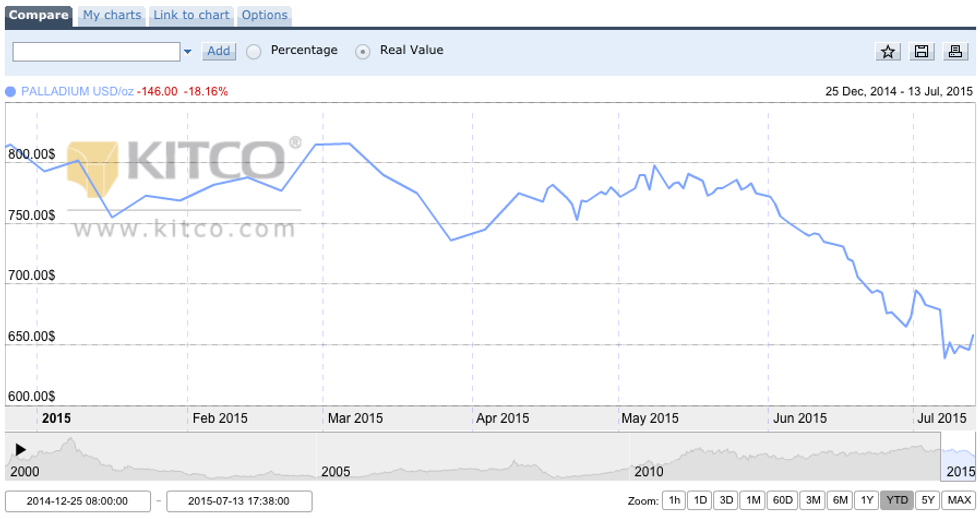
The palladium price has lost 10.75 percent in the past month and has fallen 18 percent, or $148, since the start of the year. The situation has led some firms to cut their palladium price forecasts.
While palladium performed much better than its sister metal platinum last year, the white metal hasn’t been immune to a fall in the broader precious metals complex so far in 2015.
The palladium price has lost 10.75 percent in the past month and has fallen 18 percent, or $148, since the start of the year; it is now at about $656 per ounce. Platinum has lost 13 percent year-to-date, and is currently sitting dangerously close to $1,000 per ounce at about $1,032.
Forces driving the fall in platinum group metals (PGMs) prices include a stronger US dollar and weakening demand from China. “The realization that the supply situation is not that bad and China’s demand will not explode is harming palladium,” James Cordier, founder of Optionsellers.com in Tampa, Florida, told Bloomberg back in June.
A ramp up of supply from South Africa following last year’s five-month miners’ strike has also put pressure on PGMs.
The situation has led some firms to cut their palladium price forecasts. BMO Capital Markets has revised its 2015 palladium price forecast down to US$778 from $818. It also brought its 2016 forecast down from US$880 to $820. BMO has compared palladium to nickel, noting that despite consensus bull calls last year, the metals are “now undershooting the entire commodity complex.”
“Palladium and nickel are also two metal markets that are smaller and more illiquid than others, the consequence being much higher volatility,” the firm also said. While BMO believes that supply/demand fundamentals remain intact for palladium, it also predicts that recycled palladium will offset rising demand as a growing source of supply.
Furthermore, The Bullion Desk reported last week that UBS (NYSE:UBS) has cut both its platinum and palladium price forecasts — from $1,280 to $1,160 for platinum and from $850 to $770 for palladium.
UBS and BMO are not the only firms who have cut their palladium price forecasts. Goldman Sachs (NYSE:GS) cut its palladium price forecast back on May 15 ahead of London Platinum Week, The Wall Street Journal reported. Goldman sees palladium averaging $822 in 2015, down from a previous forecast of $863. It also brought down its forecast for next year from $988 to $900.
Even earlier in the year, Reuters reported that in a poll, 31 analysts and traders put their palladium price forecasts at $810 for 2015, down from an initial call of $845.
Certainly, it appears that the bullish story for palladium has faded a bit in 2015. That said, it’s also worth noting that there have been arguments for the long-term potential for palladium that have focused more on rising demand for the metal as an autocatalyst than on rising scrap supply. Near the end of May, Bloomberg noted that demand for palladium from the autocatalyst industry was set to reach a record in 2015. Palladium is used for converters in gasoline vehicles, while platinum is used in converters for diesel engines.
“The market is bullish over the long term for palladium and the reasons are fundamental,” David Jollie, head of research at Mitsui & Co. Precious Metals, told the news outlet by phone in May. “[T]he best bullish factors are on the demand side, where car consumption is picking up and the market share of gasoline is increasing.”
Canadian auto sales rose 1.2 percent in June, and car sales in the Eurozone were up 6.8 percent in the first five months of the year — although Automotive News has suggested that the Greek debt crisis could threaten a recent recovery in the European auto market. June auto sales in China were fairly flat, as per Reuters.
Securities Disclosure: I, Teresa Matich, hold no direct investment interest in any company mentioned in this article.
